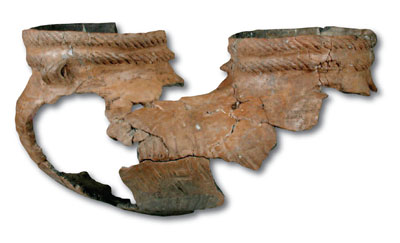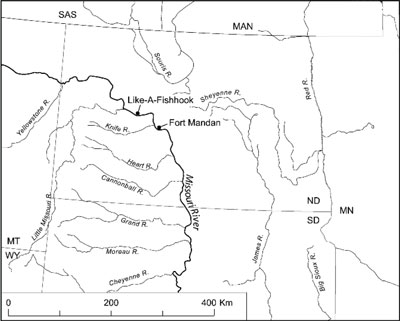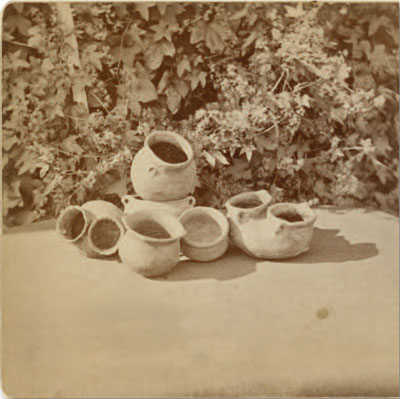
Even well-known artifacts can yield surprising new discoveries. Scholars have long believed that fragments of pottery in the Penn Museum’s collection represented the remains of two nearly identical vessels collected during the winter of 1804–1805 by Meriwether Lewis and William Clark. However, a recent attempt to reassemble the remaining pieces, undertaken in conjunction with research on 19th century northern Plains pottery production, has instead demonstrated that they belong to a single oblong pot with two necks. No vessel of this type has ever been observed in archaeological collections from the upper Missouri River region.
The Objects Of Their Journey
Lewis and Clark and the men of the Corps of Discovery reached the Mandan and Hidatsa villages near the confluence of the Knife and Missouri rivers in late October 1804. They spent most of the next month building a V-shaped log structure, dubbed Fort Mandan, in which they would pass the winter.
In his instructions to Lewis, President Jefferson had asked the captains to learn as much as they could about the native inhabitants of Louisiana and the Northwest. Throughout the long northern winter they visited the Mandan and Hidatsa villages, interviewing political and military leaders, making observations, and participating in community activities. They also collected ethnographic objects, animal skins and skeletons, minerals, and dried plants and seeds.

In early April 1805, with the spring thaw on the Missouri just underway, the Corps began making preparations for their journey to the Pacific. Six men were delegated to return to the United States with Clark’s journals and maps and the objects that had been collected during the winter. Among the items listed on the accompanying inventory was “1 earthen pot, such as the Mandans manufacture and use for culinary purposes.”
The shipment from Fort Mandan reached President Jefferson in August. Zoological specimens were sent to Charles Willson Peale’s museum in Philadelphia. Mineral samples went to the American Philosophical Society. The pot, along with other ethnographic objects, may have been displayed for a time in Jefferson’s “Indian Hall” at Monticello or it may have gone directly to the Philosophical Society. In either case, by the time it was finally transferred to the University Museum in 1937, by way of the Academy of Natural Sciences, it had been broken and some of the pieces had been lost.
The Lewis and Clark pot is classified by archaeologists as Knife River ware. The defining characteristic of this type of pottery is a vertical or out-flaring rim, reinforced at the lip by a narrow coil or strap of clay known as a “brace.” In this case, a second strap, called a “fillet,” has been added to each rim, a few centimeters below the lip. The potter decorated the vessel by pressing twine made from plant fibers into the wet clay. The downward-projecting tabs and strap handles attached to the fillet may have held a rope used to carry or suspend the vessel. The parallel grooves visible on the body of the pot were made by a carved wooden paddle, which was used to thin and shape the vessel’s walls.
Knife River ware was first produced by Mandan and Hidatsa potters sometime before AD 1600, perhaps as early as AD 1500. Over time it slowly replaced other ceramic forms, becoming the dominant style produced in the upper Missouri by the middle of the 18th century.
The Significance Of the Lewis And Clark Pot
The vessel’s form sheds light on an enigmatic stereograph taken in 1879 by Orlando S. Goff. The image, which shows a set of six earthenware pots, was taken at Like-A-Fishhook Village, the last earthlodge settlement on the upper Missouri. Among them are two double-mouthed vessels remarkably similar to the Lewis and Clark pot. Until now scholars have not known not known whether the pots in the photo, especially the two double-mouthed vessels, represented indigenous ceramic forms. The Lewis and Clark pot demonstrates that upper Missouri potters already were producing a variety of decorative vessels by the time European explorers and traders first entered the region. It now seems likely that such imaginative shapes had been a part of the upper Missouri ceramic repertoire at least since AD 1600. Recent excavations at several Mandan villages near the confluence of the Heart and Missouri rivers, some 100 km below the Knife, have revealed a broad range of ceramic forms, including broad, flat-bottomed platters, boat-shaped bowls, and jars with hexagonal and octagonal mouths. No doubt many more shapes will be identified as research continues.
This newly documented ceramic diversity helps explain an observation made in 1832 by George Catlin. A self-taught artist who traveled extensively throughout the Plains from 1830 to 1836, Catlin observed that pottery was “a familiar part of the culinary furniture of every Mandan lodge, and [is] manufactured by the women of this tribe in great quantities, and modeled into a thousand forms and tastes.” The Lewis and Clark pot shows that Catlin’s statement is more than simply a case of dramatic embellishment, a trait for which he otherwise was justly famous.

Together, the Lewis and Clark pot and Goff’s stereograph help tell a remarkable tale of cultural survival. Thirty years after the Corps of Discovery’s transcontinental journey, smallpox struck the native villages of the upper Missouri. Thousands died. The Mandans were hit especially hard, losing as much as 90 percent of their population. Eventually, the survivors worked together with the Hidatsas to establish Like-A-Fishhook Village. In 1862 they were joined there by the Arikaras or Sahnish.
Many scholars have believed that the epidemic of 1837 was responsible for a tremendous loss of cultural knowledge. Among the Mandans and Hidatsas, specialists produced many crafts, including ceramic vessels, arrows, and bison-hide boats. Ritual and sacred knowledge also was restricted to people who had purchased the right to perform a particular ceremony. Pottery production, in particular, involves many steps and stages, each of which must be completed successfully to produce a serviceable vessel. Raw clay needs to be gathered from a suitable source and mixed with other minerals to create a workable clay body. Special skills, learned only through lengthy practice, are required to shape a pot, particularly one as complex as the Lewis and Clark pot. Firing requires expert knowledge about how to build a kiln and how much fuel to use. The deaths of craft specialists could have meant the loss of their proprietary skills. However, the Lewis and Clark pot and Goff’s photo together demonstrate that the complex technical knowledge at the heart of the upper Missouri ceramic tradition survived the epidemic. As tragic as it was, the epidemic did not lead to the wholesale loss of critical cultural knowledge. People died, but the village cultures of the upper Missouri went on.
Catlin, George. North American Indians. New York: Viking Books, 1989.Gilman, Carolyn. Lewis and Clark: Across the Divide. Washington, DC: Smithsonian Books, 2003.
Jackson, Donald. Letters of the Lewis and Clark Expedition. Urbana, IL: University of Illinois Press, 1962.
Ronda, James P. Lewis and Clark among the Indians. Lincoln, NE: University of Nebraska Press, 2002.
Wedel, Waldo R. Observations on Some Nineteenth-Century Pottery Vessels from the Upper Missouri. Anthropological Papers No. 51. Bureau of American Ethnology Bulletin 164. Washington, DC: U.S. Government Printing Office, 1957.
Acknowledgments
The kind assistance of Bill Wierzbowski, Associate Keeper in the Museum’s American Section, is gratefully acknowledged. Allison Lewis completed the reconstruction of the Lewis and Clark pot. This project was supported by a grant from the University of Colorado Museum.
